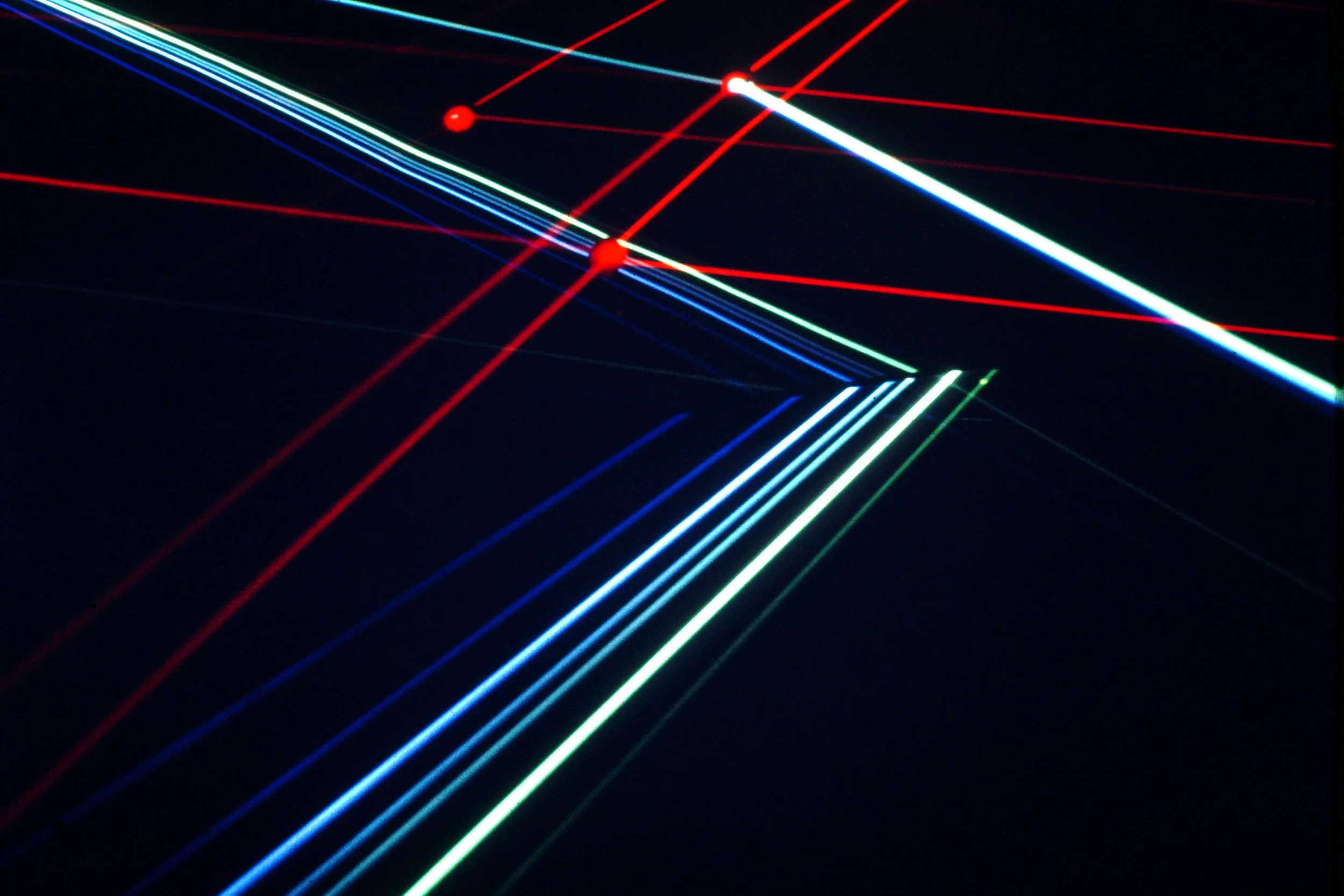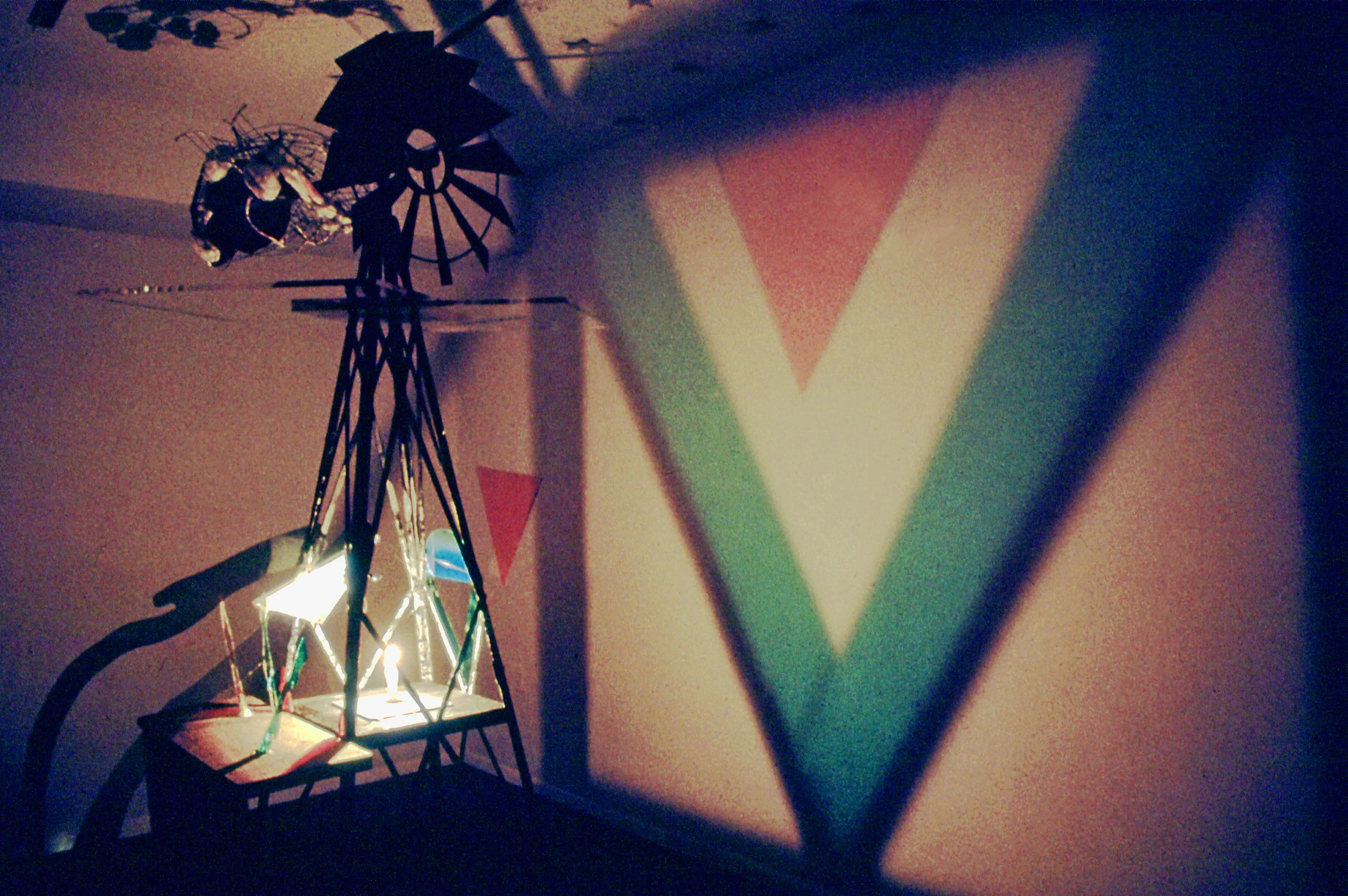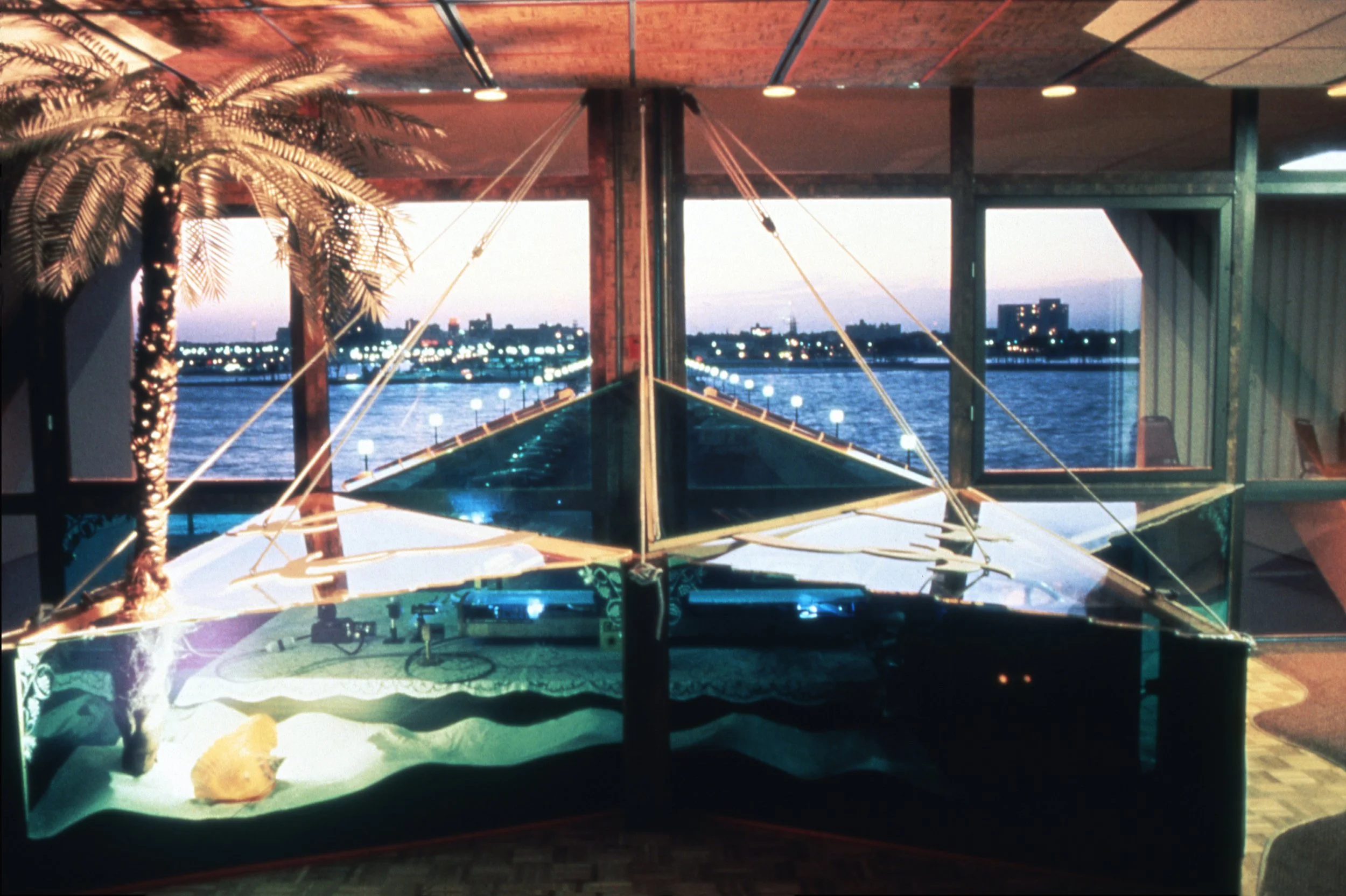Installations
Sun Dog, 1976. Solar and laser installations for the U.S. Bicentennial Expo Science and Technology, The Kennedy Space Center, Cape Canaveral, FL.
In 1976 Sun Dog was the first work of art ever commissioned by the National Endowment for the Arts.
"Rockne sure did envision new domains for sculpture and new ways for us to experience the joys of living on this earth." Benjamin Forgey, 2022
Benjamin Forgey is an architecture and art critic living in Washington, DC.

The Equestrian in Manhattan, Krebs's latest camera-obscura piece, was a complex arrangement of diverse, loosely associated objects and images fraught with spatial and symbolic ambiguities that presented a perceptual conundrum and an open field for interpretation…
The Equestrian in Manhattan, Krebs's latest camera-obscura piece, was a complex arrangement of diverse, loosely associated objects and images fraught with spatial and symbolic ambiguities that presented a perceptual conundrum and an open field for interpretation…
Krebs appropriated for this piece an ideal site for public sculpture - Downtown Manhattan's Bowling Green - and optically brought it indoors…spreading a cinematic panorama, in varying degrees of distortion, over walls, floor and ceiling. The ceiling, in addition to an inverted projection, received a right-side - up reflection from a mirror placed at an angle beneath the lens, collaging blue sky and building tops upon upside-down pedestrians moving along the pavement. Talcum powder clouds sprayed on the carpeting mimicked images of their natural counterparts floating overhead…
This optical extravaganza was, however, only part of the piece. It also served as a stage set for a sculpture that gave the work its name: a Cubist-inspired, transparent plexiglass riderless horse, perched on a wooden picnic table illuminated from beneath by black light. The plexiglass permitted light to pass directly through the horse, causing no disruption to the images projected onto the structures behind. Standing 8 ½ feet high on the table-base (the legs of which are finished with carved hoofs), and with one "toe" (as Krebs calls it in his notes) poised Gattamelata-like on a bowling ball, the horse has a plexiglass pinwheel head and chrome tail; this doubles as the crank for an old Victrola which kept playing Red River Dave's rendition of "Home on the Range.
To elucidate the full range of ironic visual metaphors and dualities of The Equestrian would require more space than is available here. My own initial response was one of sensory bombardment- a feeling of being unable to sort out and account for the welter of information contained in this chaotic "landscape." Having identified its elements, how does one construe such things as the formally apt, symbolically absurd substitution of a cannon ball by a bowling ball? ls it simply a pun on the Bowling Green location? What of the artist's invoking Monet and Donatello? Does the pin-wheel allude to Don Quixote? Where is the equestrian? And so forth. Gradually, a mock heroic eloquence settled on the piece, which began to read as a wry commentary on the increasing obsolescence of certain traditional forms of art - sculpture in particular-in today's world.”
Sarah McFadden, Art in America, November-December 1977, New York Reviews: Rockne Krebs at the Custom House.
Sculpture Minus Object, 1968, the first ever 3-D laser beam installation. Gallery of Modern Art, Washington, DC. "My first exhibit was at the Washington Gallery of Modern Art in 1968. The room was 25’ x 21’ x 11’ high. I mention the size of the enclosure because to me I’m trying to deal with the six planes, the enclosures through which our bodies move, and use light as a medium in that I am projecting the light through this space... What really prompted me to try this was the possibility of reversing the proposition by which we normally view sculpture. We normally have some kind of mass or configuration, which when it is illuminated, we can perceive this is obviously some kind of an object regardless of its medium. What I did I think was to reverse this proposition. I introduced incidental matter into the atmosphere and project light through it. The resulting configuration would be the work of art itself." Rockne Krebs, 1970
RA, 1969, Corcoran Gallery of Art. First ever solar and laser installation, 61’ x 31’ x 26’. “Krebs’ work, too, is almost without precedent. His sculpture is made of light. “Ra,” named for the Egyptian sun god, is complete less than an hour every day. Shortly after noon a rectangular bar of sunlight plunges to the floor. Lines of laser light of red and green and blue X above the viewer’s head, and an inclined plane of electric light cuts from floor to ceiling through the dark and fog-filled room. Walking through that plane of light is like walking through a wall. As the viewer moves, that sheet of light intersects his eye. He sees a slice of rainbow, and then a blinding slice of light, and then another rainbow, and the room is dark again.” Paul Richard, Washington Post, 1969, A Local Exhibition with International Appeal: In the Tradition of Washington’s Color Painters.
U.S. Pavilion, Expo ’70, Osaka, Japan, 1970. The first ever laser beam switching system and prototype of the first laser light show, Krebs’ collaboration with the Hewlett Packard Corporation, 1969-1970. New Arts, Los Angeles County Museum of Art, in Osaka, Japan.
Cut Flowers, 1970, exhibition Washington: Twenty Years, Baltimore Museum of Art, Baltimore, MD. “Krebs’ Cut Flowers, a laser piece exhibited this year at the Baltimore Museum of Art, was named for the four students who died at Kent State.” Paul Richard, Washington Post, 1970
"Also existing in time as well as space is a 100-foot long laser beam-filled corridor, designed by Rockne Krebs with Hewlett-Packard. The result is an absolutely hypnotic experience with intimations of infinity.” Henry J. Seldis, Los Angeles Times, 1971, County Museum Exhibit Mates Art and Technology. Day Passage, Rockne Krebs, interior piece, 1971. The Art and Technology Program exhibition, Los Angeles County Museum of Art, Los Angeles, CA.
Day Passage, interior piece, 1971, Rockne Krebs at the Albright-Knox Art Gallery, Buffalo, New York. Exhibition included Day Passage (interior laser sculpture) and Night Passage (outdoor laser sculpture).
Home on the Range, 1973. Exhibition Rockne Krebs: 365 Drawings and Home on the Range, Jefferson Place Gallery, Washington, DC. "Art by candlelight," Krebs' description of this piece.
For Sale: Home on the Range, Part V, A Christmas Piece & Laser Environment, 1974. A flat black X-Mas tree illuminated by neon lights and encircled by a toy train carrying scenes from the Nativity. Krebs referred to this piece as his allusive black-light piece.
Starboard (Home on the Range, Part VI), part of The Laser and Starboard (Home on the Range, Part VI), 1975, commissioned by the St. Petersburg Arts Commission and the National Endowment for the Arts. "One of the things that was also wonderful is that when this piece was working, when the laser was on, that whole Plexiglas box just kind of glowed. It was eerie and mysterious to have this glowing Plexiglas star down at one end with beams, green beams shooting out in front of it. It was mesmerizing." Glenn Anderson, 2022, former Director of the St. Petersburg Arts Commission
The Eye of Atlantis, 1973-1976, Omni International Complex, Atlanta, GA. Developed natural light plan, which was designed into the architecture. Atlantis, used sunlight and an arrangement of prisms to throw rainbow-like color on the facade. On only two days a year, the spring and autumn equinoxes, the precise configuration of hundreds of prisms and sunlight created a portrait of his daughter’s eye, visible on the facade of the building.
Picasso Play, Desire Caught By The Tail, 1984, Whitman Studio Theater, New York, NY. A collaboration piece, interactive laser stage sets. Alvin Klein, The New York Times, June 10, 1984, Desire Caught By The Tail, Picasso Play Gets Rare Showing, “…production also represents a collaboration, between Lynda Benglis and Rockne Krebs, a laser artist.” “Part steampunk, part MacGyver, and all genius. This was Rockne Krebs. His live events drew the best and brightest. I recall after a show I assisted on in New York as part of a visual extension of the stage into the audience, being with Rockne as artist after artist came up to congratulate him, among them Isamu Noguchi and Robert Rauschenberg. He was an artist’s artist.” Jason Sapan, holographer.com. Excerpt from Rockne Krebs: Photographs + Interpretations by Carol Harrison.
Laser Dance, 1985, interactive laser stage sets for the dancers and audience environment, George Washington University, Lisner Auditorium, Washington, DC. Collaboration piece with Krebs, choreographer Maida Withers and composer Bob Boilen. Maida Withers and the Dance Construction Company’s 2022 exhibition and immersive installation, LEGACY: 50 YEARS Dance on the Edge at the Corcoran Gallery of Art in Washington, DC included restored vintage video footage of Laser Dance presented on large monitors. (more information on maidadance.com) Laser Dance I (Duet), 1971, a collaboration with Maida Withers, The Maida Withers Dance Construction Company and Rockne Krebs. Performance at the Dorothy Betts Marvin Theatre, Washington, DC. “Probably the first performance of laser and dance [1971] for a live audience.” Maida Withers, 2022
A Robert Mapplethorpe self-portrait projected on the museum’s wall. “Laser Artist Rockne Krebs projected a huge, ghostly image of the dead artist on the stately façade of the building.” Newsweek, 1989, Corcoran Showdown.
Day Star, 2005, The Children’s Inn at the National Institute of Health, NIH, Bethesda, MD. A sun piece with 180 prisms, neon, large Plexiglas mobile with lily pads, clouds and four-leaf clovers, and a wall painting.

"Walking into the light sculptures was one of the things in the breakout show at the Corcoran that got me interested in Rockne's work. To this day, he, James Turrell, Dan Flavin and a few others remain in a class of their own." Philip M. Smith, 2013
Philip M. Smith was a leader in national and international science and technology policy. He was the Director of the National Research Council of the National Academies of Sciences and Engineering in the 1980s and 1990s. Previously he was an Associate Director of the White House Office of Science and Technology Policy in the Ford and Carter administrations.
New Arts, Los Angeles County Museum of Art, in Osaka, Japan. “New Arts: In a completely enclosed area in the United States Pavilion stand the results of a pioneer experiment in which industrial corporations sheltered artists in residence and gave them the opportunity to explore advanced technology and transmute it into art.”
United States Pavilion Japan World Exposition Osaka 1970, exhibition catalogue.

“I was sitting on the floor of a pie-shaped room watching images flash on the wall. There was a church and a tree and several roads which seemed to merge at crazy angles. Cars traveled along roads, met and melted through each other soundlessly. Pedestrians passed each other without acknowledgement. And all the images were upside down!
A dream? Not at all. There entire room is a work of art by Rockne Krebs – part of the “Projected Images” exhibit at Walker Art Center. The Krebs room, entitled “The Lock (Home on the Range Part III),” is one of the more fascinating environments in the exhibit.
After several minutes of wondering what was going on, I began poking around the room and was dumbfounded to discover that the images were reflections of the landscape outside Walker, routed into the room by a series of mirrors. Pull my beard and call me Plato – I was in a “camera obscura!” Steve Kaufman, Critics Corner, SkyWay News, Minneapolis-St. Paul, 1974.
The Lock, Home on the Range Part III, camera obscura projection installation, laser structure, reflective paint, astroturf, live tree, and mirrors. Projected Images: Campus, Krebs, Sharits, Snow, Victoria, Whitman, Walker Art Center, Minneapolis, MN, 1974.
Projected images is what the exhibition is all about. It is not, per se, what Rockne Krebs is all about, although a major element of The Lock (Home on the Range, Part III) is a projected image: a camera obscura. Krebs is a sculptor who is primarily concerned with space, light, and natural phenomena. If a projected two-dimensional image happens to provide an expressive vehicle for these concerns, there is no reason, he feels, to shun a medium because it happens to be more akin to painting. Initially, therefore, it is worth exploring how his use of the camera obscura (in conjunction with beams of laser light) relates to the evolution of a major aspect of the artist’s development since 1967.
Jeremy Meckler, Artists’ Cinema: Projected Images, Walker Art Center, 2011















